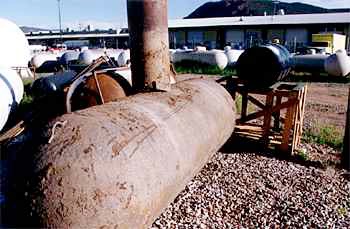A Word About Coatings
- Home
- A Word About Coatings
All steel objects are painted to keep them from rusting. The paint is a
waterproof barrier between the steel surface and moisture in the air.
Similarly,
underground tanks need a waterproof coating to protect them from corrosive
groundwater. Ordinary paint coatings do not hold up under constant contact
with
mineralized moisture in the earth. Specialized coatings are needed to
withstand
the corrosive environment underground and provide a barrier between the
steel
surface and air, water and even electricity without deteriorating over time.

The first line of defense against corrosion on an underground tank is a good
coating. Paint and coating companies make a variety of coatings for a vast
array
of applications. It is important to apply those that will hold up over time
to
constant attack by water, oxygen, carbon dioxide, mild acids, mechanical
abrasion from rocks, earth movements, roots, bacteria and other biological
organisms as they feed on organic compounds in them. They must be applied
correctly or they will not adhere to the steel surface. The tank
manufacturer
often applies a tough, chemical and water resistant coating at the factory.
Factory applied coatings include baked on powder paint, sprayed on
chemically
cured epoxy resins, electrostatically applied fusion bond epoxy and sprayed
on
coal tar or petroleum based enamel. Field applied coatings are usually brush
applied enamels, mastics, polyurethane, reinforced plastics or epoxies. If
you
have an underground tank or are planning to install one and can scratch off
the
coating with a pocket knife, it will not prevent corrosion underground. You
should apply a second coating made for underwater or underground use. If you
are
located far from a large metropolitan area and do not have the luxury of
applying one of the above, you may find one made to resist water in stock at
a
local boating supply store.
Coatings alone, will not protect a buried tank against corrosion. They are
scratched, scraped and gouged during handling, setting, backfilling and
settling. They can have small imperfections or missed spots here and there.
Some
deteriorate underground. Corrosion pitting rates are greater at these flaws,
scratches and gaps in the coating than they are on completely bare tanks.
Cathodic protection with anodes is needed to protect the steel wherever it
is
exposed.